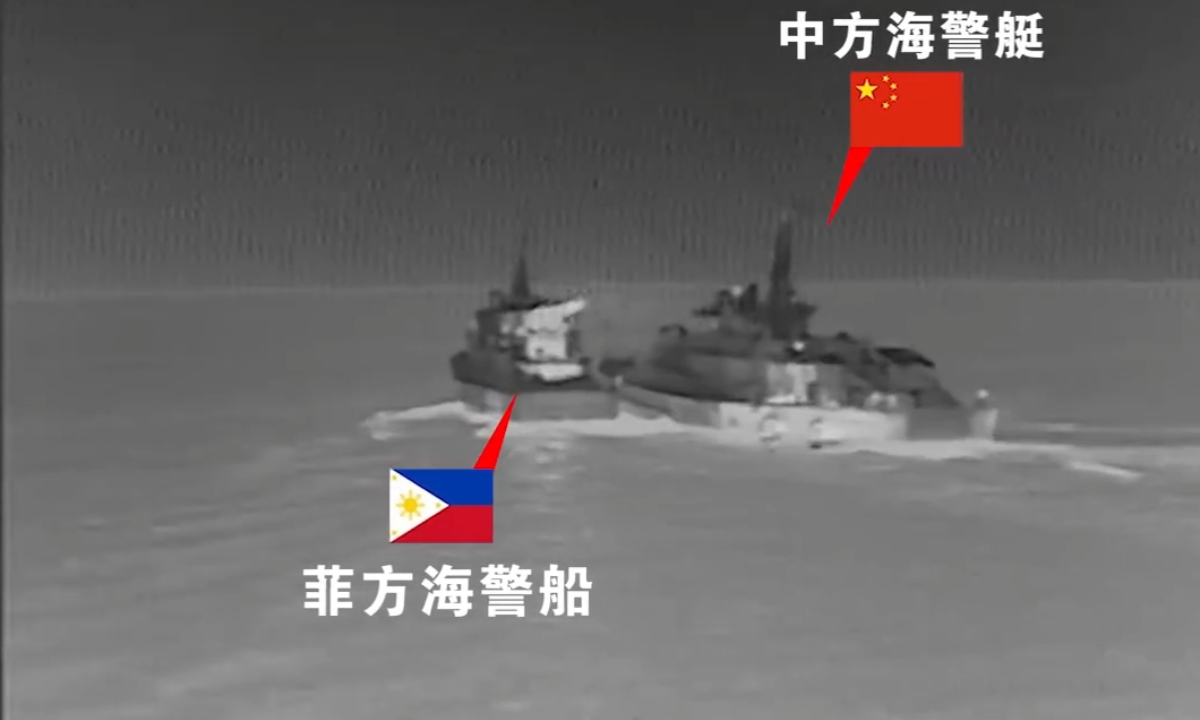
The Philippine Coast Guard ship MRRV-4410 suddenly turns right and rams into the China Coast Guard (CCG) Vessel 21551 at 3:25 am, August 19, 2024. The Philippine Coast Guard ships MRRV-4410 and MMRV-4411 illegally intruded waters adjacent to Xianbin Jiao on August 19, 2024, and the CCG conducted restrictive measures in accordance to the law. Photo: Screenshot from the Weibo account of the CCG
The Philippines on Monday once again sent ships to intrude waters off China's Xianbin Jiao in the South China Sea, but once again saw its provocation restricted by the China Coast Guard (CCG).
By making consecutive provocations at and around multiple Chinese islands and reefs from both sea and air over the past week or so, the Philippines is escalating tensions and harming peace and stability in the region, which the Chinese side's restrained countermeasures aim to safeguard, Chinese experts said.
Philippine Coast Guard Ship 4409 and Ship 4411 illegally intruded into the waters adjacent to China's Xianbin Jiao on Monday without authorization from the Chinese government, dangerously approaching the CCG ships normally sailing in the area, and hyped the incident, the CCG said in a press release on Monday.
The CCG took restrictive measures against the Philippine vessels in accordance with law and regulations, it said.
Over the past week or so, the Philippines has made consecutive provocations near multiple Chinese islands and reefs in the South China Sea.
On August 19, the Philippine Coast Guard ships MRRV-4410 and MMRV-4411 illegally intruded waters adjacent to Xianbin Jiao, and after being dealt with by the CCG with legitimate restrictive measures, the MRRV-4410 again illegally intruded waters adjacent to Ren'ai Jiao, once again met with CCG's restrictive measures, according to the CCG.
On Sunday, Philippine Ship 3002 trespassed into waters off Xianbin Jiao and carried journalists to distort facts and hype the incident. The CCG conducted professional and legitimate moves to firmly block and drove away the Philippine vessel.
The Philippines made infringing provocations not only from the sea surface, but also in the air.
On August 19, a Philippine Cessna 208B Grand Caravan aircraft flew over China's Huangyan Dao, leading to a Chinese fighter jet to release flares in an apparent move to warn the Philippine aircraft away from the Chinese island, according to a report by the Philippine Daily Inquirer.
Most of the recent China-Philippines maritime encounters have taken place at sea surface when Philippine vessels attempted to trespass into waters adjacent to Chinese islands and reefs, but the Philippines is apparently ramping up the deployment of aircraft in its provocations, a move observers said has more risks of accidents.
Chen Xiangmiao, director of the World Navy Research Center at the National Institute for South China Sea Studies, told the Global Times that the Philippine government seems to have no intention to keep any consensuses reached by the two sides over the South China Sea, and its lack of good faith means any kind of temporary arrangements can only be "painkillers" that cannot resolve differences from the roots.
If the Ferdinand Marcos Jr administration insists on acting willfully, define China-Philippines relations only by the South China Sea issue and take on unilateral actions at and around Chinese islands and reefs in the region, it will only end up suffering the consequences of its own actions, Chen said. So far, China has exercised a considerable degree of restraint on this issue, and the measures taken by the CCG have remained relatively soft, but China's patience is not unlimited, observers said.
Cognitive warfareEach time the Philippines proactively makes provocation and meets with restrained restrictive measures from China, it plays "victim" in moves to smear China in part of the Philippines' cognitive warfare, analysts said. It was the Philippine ships and aircraft that had come too close to the Chinese islands and reefs, or had already violated Chinese sovereignty in the first place, forcing the Chinese side to take countermeasures.
Ding Duo, deputy director of the Institute of Maritime Law and Policy at China's National Institute for South China Sea Studies, told the Global Times on Monday that there is a well-documented history of provocative behavior by the Philippine vessels against the CCG in the South China Sea in the past two years, which includes dangerous maneuvers such as dangerous sailing, deliberate collision, and other forms of harassment that put Chinese vessels at risk.
The Philippine rhetoric ignores this pattern of behavior, and its narrative of "threats to safety and freedom of navigation" by Chinese vessels is part of a broader strategy to mislead international audiences and justify its provocative actions, Ding said. "By framing itself as the 'victim,' the Philippines attempts to obscure its violations of international law including the UN Charter and its continued violation of China's sovereignty," Ding noted.




